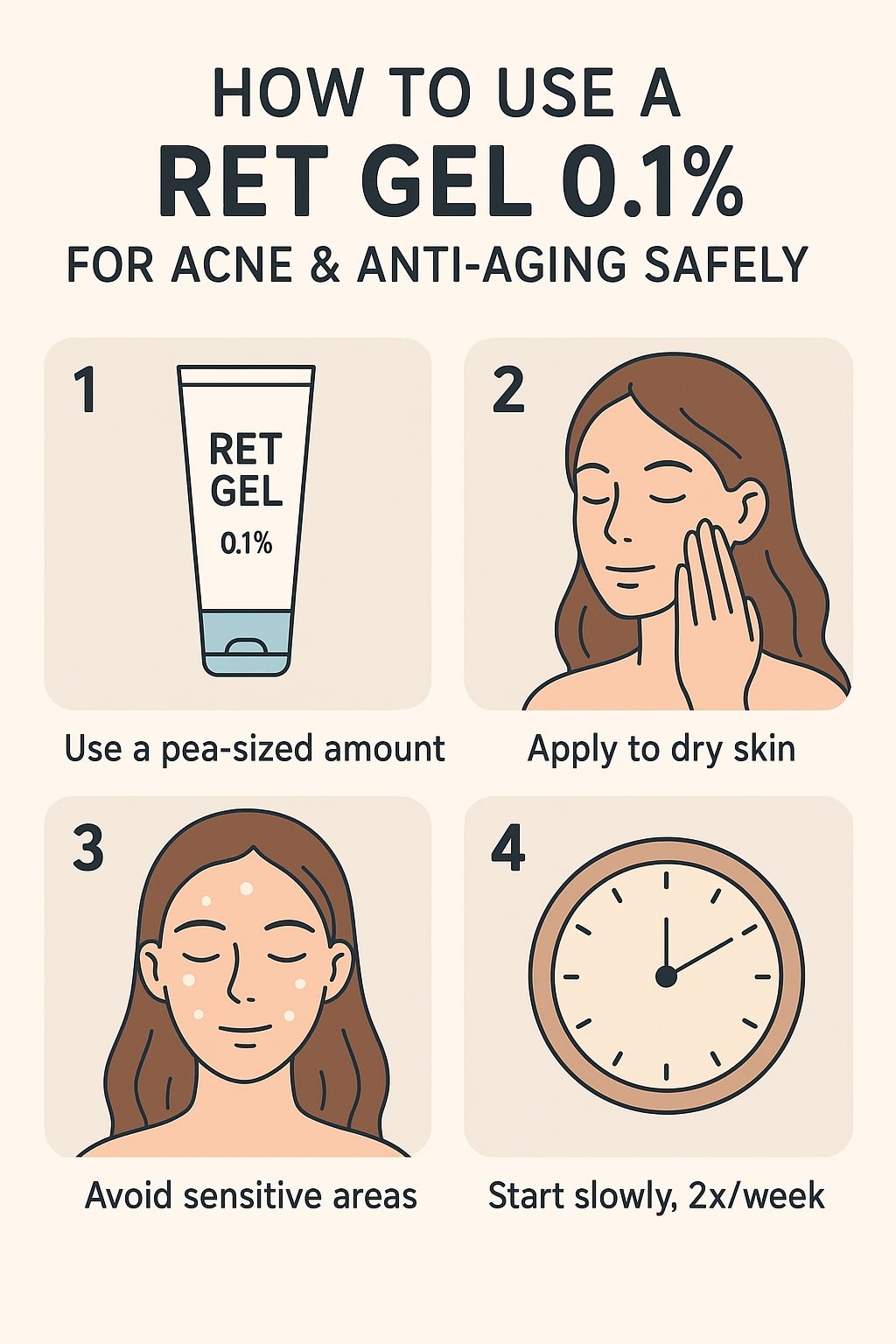Most people experience acne at least once in their lives. Acne, the common skin condition, does not discriminate in its appearance or effects by race, gender, geography or culture. It targets many individuals, but its severity (from mild to moderate to severe) greatly varies from person to person.
This page will discuss acne, its treatment options, including A Ret Gel 0.1%, and explore its uses, applications, methods, and more. Before learning how to use A Ret Gel .1%, let’s take a look at some basic information on acne.
Acne occurs when skin pores (hair follicles) become clogged with sebum (oil), dead skin cells, and sometimes bacteria. Acne pimples often appear on the face (especially cheeks, chin and nose). It can also affect the chest, back, and shoulders. The exact cause of acne is not fully known, but excess oil production, clogged pores, hormonal changes, bacteria, and inflammation are some of the common causes of acne.
The treatment may depend on the type of acne you experience. Whiteheads, blackheads, pustules, papules, nodules, and cysts are all referred to as acne. Mild acne can be treated with natural remedies and self-care; however, a consultation with a dermatologist is important to get the best treatment advice for moderate to severe acne.
Identifying common triggers can greatly help manage acne reasons such as hormonal fluctuations, stress, genetics, high sugar or dairy-heavy diets, consuming too much oily food, usage of harsh chemical-based skincare products, certain medications and extreme sun exposure.
Treatment of acne vulgaris
Treatment of acne vulgaris varies depending on the severity. Most commonly, dermatologists prescribe topical formulations along with oral medicines to treat acne. In severe cases, the treatment may include hormonal therapies, chemical peels, cyst drainage, and light & laser therapies.
In topical formulations, Tretinoin (also known as all-trans retinoic acid), benzoyl peroxide, and salicylic acid are the most prescribed options for acne treatment.
What is A Ret gel 0.1%?
A Ret gel is a powerful topical medicinal (retinoid) formulation prescribed to treat acne vulgaris and reduce signs of ageing (like fine lines, uneven skin tone and skin texture). It contains Tretinoin 0.1% as the main active ingredient, and it is a potent derivative of vitamin A. Tretinoin increases cell turnover, boosts collagen, unclogs pores, and fades marks of hyperpigmentation when used per regimen.
How to use A Ret Gel .1% safely?
As your goal is to treat acne and signs of ageing, you will likely benefit from A Ret gel. Tretinion is a top skincare component clinically proven to address acne by reducing inflammation, unclogging pores, and preventing new breakouts. Additionally, it reverses signs of ageing by boosting collagen, fading hyperpigmentation, and reducing fine lines.
Using A Ret Gel .01% is safe enough when following the instructions provided by the dermatologist. The common steps to use A Ret gel include:
Start slowly – Begin the application 2-3 times weekly on an alternate basis and gradually increase to apply it daily, as your skin builds tolerance.
Application time – Tretinoin can make your skin more sensitive to sunlight, so it’s best to apply this formulation at night, 30 minutes before bedtime.
Application methods – Following the correct application methods is essential for achieving the desired outcomes. A Ret gel application step includes the following:
- Cleanse your face with a gentle, preferably non-comedogenic cleanser.
- Let your face dry fully and wait for 5-10 minutes after cleansing your face.
- Take a pea-sized medicinal gel and apply it evenly on the acne-affected skin area.
- Avoid applying the product in sensitive areas, such as the under-eye, nose corners, and lips.
- If you have sensitive skin, use a light moisturiser, wait for 5-10 minutes, and then apply Tretinoin.
- Be consistent with treatment duration to experience the results.
- The treatment may take up to 3 months to reverse acne and 6 months to balance skin tone, reduce fine lines, and hyperpigmentation.
Things to avoid – Avoid using multiple acne treatments while using Tretinoin, especially benzoyl peroxide, vitamin C, AHA/BHAs, exfoliants, harsh scrubs/toners and heavy fragrances. Also, avoid waxing the treatable area, as it can cause skin peeling and bleeding.
Apart from this, using SFS 30+ sunscreen is essential when stepping outside the home.
Safety and precautions – Pregnant and breastfeeding women are not advised to use Tretinoin. Patients taking other medications or suffering from rosacea, eczema, or having extremely sensitive skin should inform their dermatologist about their skin condition.
Additional skincare tips for acne-prone skin
- Use non-comedogenic products
- Wash your face twice daily with a gentle cleanser and 2-3 times with normal water (without cleanser) to remove excess skin oil. Avoid over-washing or using harsh scrubs.
- Don’t touch your acne pimples, except when applying medication.
- Eat a balanced diet and avoid high sugar or dairy-heavy diets.
- Consult your dermatologist from time to time to stay updated during the treatment duration.
- People with dry skin should not forget to moisturise their skin with a mild or prescribed moisturiser.
- Be patient during the treatment and don’t stop the medicine abruptly. Doing this can make your acne worse.
Summary:
Acne is treatable with the right approach. Consulting a dermatologist is recommended when dealing with a moderate to severe acne condition. Tretinoin A Ret gel 0.1% is one of the best-prescribed topical formulations that helps eliminate acne and signs of ageing. For authentic product supply, you can buy Tretinoin online from PremiumRxdrugs at affordable prices.
Marie
Latest posts by Marie (see all)
- Hydroquinone vs Non-Hydroquinone Creams: Which Is Better for Melasma? - December 8, 2025
- Triple Combination Cream: Fastest Way to Fade Melasma and Pigmentation - November 26, 2025
- How to use Glyco cream for pigmentation, dark spots, and melasma? - November 21, 2025




